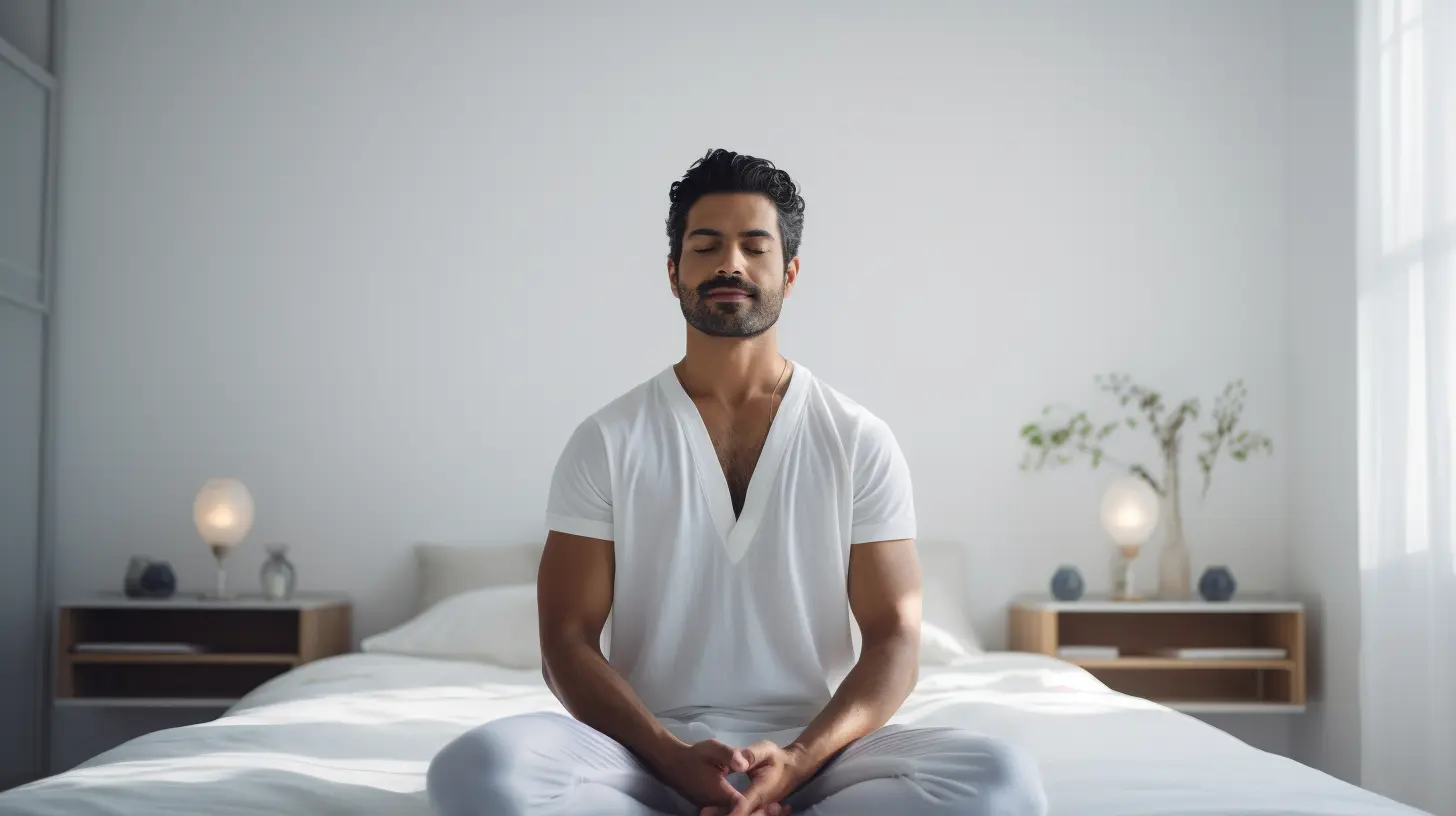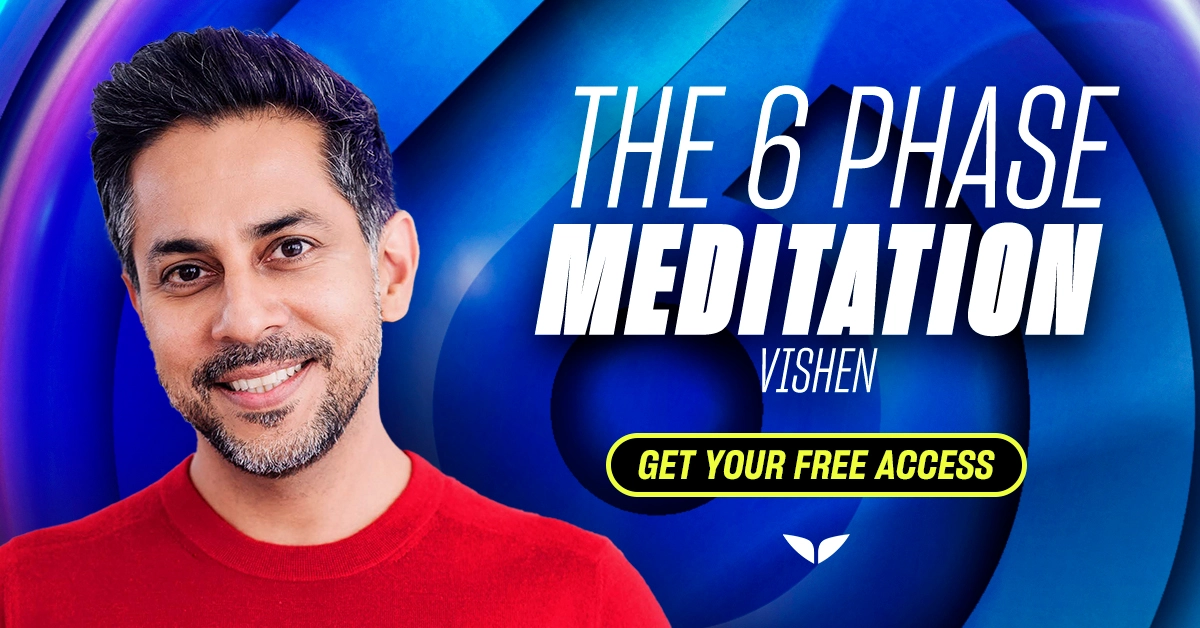Modern life can feel like a never-ending marathon. You wake up with a million things to do, so naturally, by the time you finally crawl into bed, meditating is the last thing on your mind.
But what if you can still make time for it… by learning how to meditate in bed?
That’s right; you don’t need to sit cross-legged on the floor for hours on end. Actually, you can do it where you’re most comfortable… snuggled up in your sheets.
The best part? Meditating in bed doesn’t just help you relax; it can also unlock your hidden superpower for deeper sleep and a clearer mind.
Once you master it, you’ll wonder how you ever ended your day without it.
How to meditate in bed for beginners: 5 tips endorsed by experts
“But what if I fall asleep instead?”
Well, here’s some good news: Learning how to meditate in bed before sleep isn’t at all about zoning out in a horizontal position. Through a series of steps, you’ll realize that it actually helps you relax more deeply, reduce stress, and boost your overall well-being… without dozing off.
Sure, meditating in bed may seem like a simpler, scaled-down version of the classic lotus position. But the thing is, small adjustments like this can still have a big impact.
Even a 15-minute meditation practice can have a huge impact on your mental and physical health. So, this gentle twist on an ancient ritual can deliver major results—even from the comfort of your sleeping quarters.
Here are five expert-backed tips to help you transform your bedtime routine into a powerful hack for self-improvement.
1. Know why you want to meditate
Setting your intention before you meditate is literally an act of telling your brain what you want to achieve—whether it’s less stress or better sleep.
Emily Fletcher, a meditation coach and the trainer of Mindvalley’s The M Word Quest, believes setting an intention before meditating is key. It not only helps you ground yourself but also directs real improvements you want to make in life.
“The point of meditation is not to get good at meditation; the point of meditation is to get good at life,” she says.
So, here’s how you can do it intentionally:
- Write down what you hope to gain from your meditation session—whether it’s calming your mind or gaining clarity on an issue.
- Visualize what success looks like for you—whether it’s feeling peaceful or more focused.
- Use meditation apps like Mindvalley to track your practice and revisit your intentions before each session.
- Rely on affirmations such as “I am calm” or “I am present” to anchor your intention throughout your meditation.
2. Set up your bedroom for optimal focus
Your bedroom environment can make or break your meditation practice. A thoughtfully designed space will help you sink into a state of relaxation and focus, ensuring you get the most out of each session.
Whether it’s prepping for an evening meditation or gearing up for a peaceful morning start, the proper setup can really maximize your experience.
The goal here is to create an atmosphere that tells your mind and body it’s time to shift gears and dive into meditation. You’d only need minor but effective tweaks to turn your bedroom into a serene, distraction-free zone.
Here are ways to prepare your environment:
- Dim the lights. Soft lighting can help you relax and signal to your brain that it’s time to unwind.
- Use calming scents. Essential oils like lavender or eucalyptus can elevate your meditation practice by stimulating your senses and promoting relaxation.
- Keep your space cozy. Ensure your bed is comfortable, with pillows and blankets arranged in a way that supports your body without making you too drowsy.
- Minimize distractions. Remove any clutter, silence your phone, close your laptop, and reduce any unnecessary noise to keep you focused and centered.
3. Learn to breathe better
Breathing can anchor your mind during meditation. When you focus on your breath, it brings your attention to the present moment and helps calm your thoughts.
Vishen, the founder of Mindvalley and creator of The 6 Phase Meditation, suggests syncing with your breath to manage thoughts during meditation. Why? “We don’t ignore our thoughts. We bring them into our being and transform them,” he explains in the Mindvalley Quest with the same name.
What’s more, by focusing on your breath, you switch off your body’s “fight or flight” response by activating the parasympathetic nervous system. This part of your body is responsible for calming you down and helping you recover from stress.
Think of breathwork as a gentle way to quiet your mind instead of forcing it into silence (which never works anyway). Here’s how to do it:
- Start simple. Focus on the natural rhythm of your breath—inhale slowly through your nose, exhale through your mouth.
- Count your breaths. A simple technique is counting each breath up to 10 and then starting again. This keeps your mind engaged without drifting off.
- Breathing exercises. You don’t always have to keep to the same rhythm each time. Spruce things up by trying different breathing techniques.
4. Try dynamic meditation positions
Is it hard for you to sit still for long periods? Do you tend to get restless a lot? Then, dynamic meditation might just be right up your alley.
Unlike traditional meditation practices that require you to sit in one spot, dynamic meditation allows you to move, stretch, or adjust your posture without losing focus. It’s ideal for anyone who can’t stay still or is bogged down by a mind that refuses to quiet down.
Vishen waxes lyrical about dynamic meditation for busy, modern lifestyles. As he would aptly put it, “Dynamic meditation is about embracing this busy creative world we are in.”
So, forget suppressing your energy. Enhance your focus during meditation in bed by embracing more movement.
How to do it:
- Stay flexible. Don’t worry about sitting still or holding a rigid posture. If you feel the need to move, go ahead. Adjust your position, stretch, or even scratch an itch—it won’t disrupt your meditation.
- Let your mind work with you. Instead of pushing thoughts away, explore them. Bring them into your practice and let them roam naturally. The key here is to not lose your awareness of them.
- Try walking meditation. If you find lying in bed doesn’t suit you, try a walking meditation. Slowly pacing your room while focusing on your breathing can help channel your energy and still achieve mindfulness.
5. Make sleep meditation a habit
The key to reaping the long-term benefits of meditating in bed is consistency. It’s not just a one-off practice that magically fixes everything. You need to build it into your daily routine, just like brushing your teeth or getting dressed in the morning.
According to Emily, meditation should be a non-negotiable part of your day.
You don’t go a day without brushing your teeth, and I don’t want you to go a day without meditating,” she highlights in her Mindvalley Quest. So, the only way to make meditation in bed a habit is to just do it regularly.
How to do it:
- Set a daily reminder. Use an app or alarm to remind yourself to meditate at the same time every day—whether it’s in the morning or before bed.
- Start small. Don’t overwhelm yourself with long sessions at first. Even five minutes of meditation daily can make a huge difference.
- Track your progress. Turn to journals or meditation apps to keep tabs on your streaks and celebrate your success.

5 benefits of meditation while lying in bed
Ultimately, going all zen in your resting chambers, à la Dr. Strange, has more benefits than one. And the best part? You get to do it and reap its incredible benefits while wrapped up in your coziest blanket—no adherence to strict rules, necessary.
1. Improved sleep hygiene
After a long day filled with endless tasks and constant screen time, shutting off your mind can feel impossible. Here’s where meditation steps in as a solution. It offers a gentle way to signal “rest mode,” giving your brain the break it craves.
You see, this practice is a natural method for improving sleep hygiene. Research, for one, has shown that it’s a valuable tool for treating chronic insomnia. So, by incorporating meditation into your pre-bedtime routine, you’re setting yourself up for more quality rest.
Imagine waking up refreshed and clear-headed, ready to tackle every new day—all because you gave your mind the reset it needed. Who wouldn’t want that?
2. Emotional balance
Life’s chaos can leave you feeling emotionally drained, with your mind racing through every little stressor. Learning how to meditate in bed for anxiety can be your emotional reset button, helping you regain balance when everything feels overwhelming.
Remarkably, regular meditation reduces anxiety and stress, making it easier to manage emotions. Doing it regularly before bed, therefore, helps you shift into a calmer state and process feelings more effectively.
With each session, you can start to feel more in control and emotionally resilient for whatever the next day throws your way.
3. Sharper focus
Did you know that mastering how to meditate properly in bed can help sharpen your concentration? So if you’re struggling with distractions during the day, this can do wonders for you—even before your feet hit the bedroom floor.
Plus, regular meditation improves your attention span and impulse control, making you less dependent on excessive brain activity to maintain focus. By starting or ending your day with a quick session, you train your brain to handle tasks more efficiently.
4. Increased self-awareness
It’s easy to lose touch with yourself when life moves at a million miles an hour. Thankfully, meditation offers a moment of stillness to reconnect and reflect on how you feel—both mentally and physically.
Research shows that regular mindfulness practices, like meditation, improve emotional regulation and increase self-awareness by activating areas of the brain linked to introspection and empathy.
It’s no wonder this practice can help you understand yourself and your needs better. And it’s even better that it can be done before you sleep and after you wake up (ah, the convenience).
5. Improved eating habits
If you find yourself reaching for snacks late at night or eating out of stress, contemplative mindfulness in bed could be your secret weapon to overcome the habit.
Mindfulness meditation, for one, is evidently great for reducing binge and emotional eating, even though it may not directly lead to weight loss. By helping you become more aware of your body’s hunger signals, it creates a mental buffer between your cravings and bodily actions.
Need more incentive? Imagine the added value of curbing impulsive eating this zen way: greater self-control, confidence, and a healthier relationship with food.
How to meditate in the evening
Meditating in bed in the P.M. is your chance to hit the reset button after a long day—all while deepening your spiritual practice.
Here, this practice is less about becoming productive—which is the narrative typically circulating everywhere in the world, including the global self-help industry—and more about clearing your mental clutter. With a clearer mind, you get to transition into a restful state with as much ease as possible.
Here’s how to turn your evening practice into a peaceful, transformative experience:
1. Start with a body scan
This technique helps release physical tension and grounds your mind, bringing you into the present. It’s an effective way to signal to your brain that it’s time to rest.
How to do it:
- Settle into your bed. Lie flat on your back, arms resting gently by your sides, with your legs slightly apart.
- Focus on your toes and notice any sensations—warmth, coolness, tension. Take a slow, deep breath, and imagine those digits softening and relaxing with each exhale.
- Shift your focus slowly from your feet to your ankles, then your calves, and so on, working your way up your body. At each step, release any tension you feel by breathing deeply into that area.
- Pay attention to your back and shoulders, the areas that often hold a lot of tension. Consciously release any tightness with a deep breath.
- End the scan with your face. Relax your jaw, soften your forehead, and let the muscles around your eyes release any tension. By the time you reach the top of your head, your body will be in a fully relaxed state, ready for sleep.
By scanning your body and consciously relaxing each part, you’re telling your brain that it’s time to wind down. From here, it’s much easier to transition into the restful state you deserve.
2. Rely on calming mantras
Cliché as it sounds, words really do hold the power to affect your vibration and perception.
By repeating calming mantras, you can guide your mind away from stress and invite tranquility into your evening.
Suggestions for mantras:
- “I release the stress of the day.”
- “I am calm, and I am peaceful.”
- “With each breath, I let go of what doesn’t serve me.”
- “I welcome rest.”
- “I am safe, I am serene.”
Choose a mantra that speaks to an existing need (whether it’s peace or safety, for example), and repeat it slowly. Even better, sync it with your breath to cultivate more profound relaxation.
3. Practice mindful listening
In the stillness of the night, tune into the sounds around you—whether it’s the hum of your fan or the quiet outside your window.
Let your mind focus on these sounds without judgment. This simple act of listening can help drown out internal noise and keep you in the moment.
On the noisy nature of thoughts, Vishen says, “We don’t clear away thoughts; we use them to create beautiful emotional states.” So, by focusing on the sounds around you, you can shift your attention from any wandering thoughts and learn to recenter yourself.
This feat will become second nature in time… when you champion how to meditate in bed.
How to meditate in bed in the morning
Just as evening meditation helps you wind down, morning meditation sets the stage for how you’ll face the day ahead.
By turning to this zen practice first thing in the day, you get to wake up with more clarity and a renewed mindset for tackling the day ahead. And here’s an incentive for you: it’s the go-to tried-and-tested hack for the world’s top performers, from Oprah and Arianna Huffington to Tim Ferriss and Jerry Seinfeld.
So, time to make your morning meditation count with these three steps.
1. Start with mindful breathing
Before your eyes even open, begin your day with slow, deep breaths. Doing this not only eases lingering drowsiness but also shifts your brain into the present moment.
Morning breathwork activates your mind while gently waking up your body, ensuring you start the day centered.
Here’s a quick step-by-step to follow:
- Inhale deeply through your nose.
- Hold for a count of four or eight (depending on your preferred capacity).
- Then, slowly exhale through your mouth.
Repeat this for a few rounds to bring a sense of calm and alertness.
2. Use energizing affirmations
When you’re starting your day, you want words that spark energy and clarity, setting a solid mental foundation. So the affirmations you use in the A.M. should be energizing—and different from the ones used in the P.M., which should help you wind down.
Think of your morning affirmations as mental fuel, prepping your mind for a successful day. Here are some suggestions to consider and try out.
- “I am energized and ready for the day.”
- “I am focused and clear-headed.”
- “I approach today with confidence.”
- “I welcome today’s challenges and opportunities.”
- “I am calm and centered as I move through my tasks.”
These affirmations help align your mindset with how you want your day to unfold, setting a positive tone right from the start.
3. Visualize your entire day ahead of you
Rather than just imagining your entire day in broad strokes, narrow your focus during meditation as part of your ideal morning routine.
By picturing a smooth, productive start to your day even before you hit the ground running, you’re setting the stage for a successful day to unfold.
So, follow this easy guide to get going:
- Visualize yourself getting out of bed feeling refreshed and energized.
- Picture moving through each morning task effortlessly—whether it’s making your bed, prepping a healthy breakfast, or getting ready for the day.
- Imagine starting your first task or meeting with focus and positivity.
- Concretize your plans by scheduling critical tasks on your calendar once you’re up.
This no-nonsense approach gets you to kick-start your morning with purpose and clarity, keeping you grounded and focused as the day begins.
BONUS: The best playlist for meditating in bed
The right meditation playlist can make all the difference, whether you’re looking to drift into a peaceful slumber or set a serene tone for your morning.
As nature intends it, sound heals. It’s no wonder that having the right soundscape at your fingertips can easily turn your meditation into a seamless experience that enhances your focus while reducing stress levels.
Below, you’ll find seven selections to complement your practice—night or day.
1. The 6 Phase Guided Meditation by Vishen
Created by Vishen himself, this meditation guides you through six transformative phases that can drive up inner peace, mental clarity, and emotional resilience.
“Through this practice, we stack transcendent practices that create the biggest uplifts in human well-being, Vishen explains.
Ideal for both morning and evening, this 15-minute meditation will leave you feeling grounded and ready to face whatever comes your way.
2. Powerful Guided Meditation for Deeper Sleep and Healing by Niraj Naik
Designed specifically for the P.M., this soothing meditation by breathwork expert Niraj Naik is perfect for winding down after a hectic day.
With its focus on deeper sleep and inner healing, it helps you release tension and stress, guiding your body into a state of relaxation.
You’ll drift off effortlessly, allowing your body’s natural healing processes to kick in overnight.
3. Surrender to Deep Sleep: A Guided Meditation for Relaxation by Nalaya Chakana
Tailored for those restless nights, this meditation is your ultimate tool for surrendering to sleep.
With calming cues and gentle affirmations, the soothing voice of Nalaya Chakana gently guides you, helping you let go of the day’s worries and ease into rest.
Perfect for the P.M., this track is the ideal tool to help prepare you for deep, uninterrupted sleep.
4. Powerful Morning Meditation for a Beautiful Stress-Free Day by Sonia Choquette
This morning meditation by spiritual teacher Sonia Choquette is all about setting the tone for a stress-free, beautiful day.
It’s uplifting and energizing, guiding you to release any tension left over from sleep while instilling a sense of calm confidence.
5. Guided Meditation: Clearing Foreign Energy by Jeffrey Allen
Let’s face it—through daily encounters with people and challenging situations, our aura absorbs a lot. This meditation by energy healer Jeffrey Allen helps cleanse that energetic buildup, restoring balance and calm.
Best suited for an evening routine, it helps release any residual negativity or “foreign energy” accumulated throughout the day.
With Jeffrey’s gentle guidance, you’ll feel mentally lighter and more grounded, making this track the perfect companion for your pre-sleep ritual.
Unlock your brilliance within
Meditation in bed isn’t just a nighttime or morning routine—it’s a powerful tool that can reset your mind, sharpen your focus, and ease the weight of daily stress.
From deepening your emotional resilience to fostering mental clarity, this simple practice can shift how you move through life—all from the comfort of your sheets.
Now, imagine taking this practice to the next level. The free 6 Phase Meditation Quest on Mindvalley is designed to guide you through a seven-day journey that rewires your mind for fulfillment. With Vishen as your daily coach, you’ll learn how to:
- Establish a daily meditation practice you love
- Master six transformative phases of effective meditation
- Boost your capacity for empathy and connection
- Release emotions that no longer serve you, and
- Unblock your intuition, the only compass you’ll ever need.
Author Kristy Longfellow once struggled with depression, alcoholism, and a broken marriage. But thanks to the Quest, she could change the course of her life—something she never thought possible. Here’s what she has to say:
“I did the Limitless Course and practiced the 6 Phase Meditation daily. During the course, I quit a lifetime drinking problem and went through a divorce after 13 years of marriage. After the course, I wrote and published a book about my healing journey called Messy Miracles. Looking back, [the experience was my ‘beautiful destruction’ and changed my life for the better.”
What makes The 6 Phase Meditation so powerful is its flexibility. You can easily adapt the practice to your routine—whether you meditate in bed or follow a more traditional path. It’s not about rigid rules but finding what works for you, which makes it a perfect companion for whatever other Quest you’re on.
Just ask financial risk analyst Rahim Kassam:
“Perhaps the most impactful aspect of The 6 Phase Meditation is how well one can integrate elements from other Mindvalley Quests. I find that 6 Phase allows one to maintain and enhance previous teachings into a single unified practice, particularly in Phase Four. Thank you, Vishen, for creating such a magnificent program.”
Whether you use it as a transformative path on its own or a springboard for other life-enhancing journeys—in bed or beyond—this Quest will help unlock your mind’s full potential.
So, don’t be afraid to lean in; your new life of clarity, calmness and purpose awaits you.
Welcome in.










